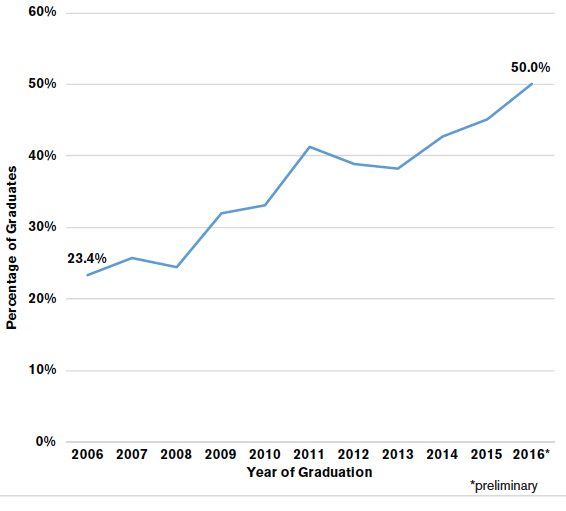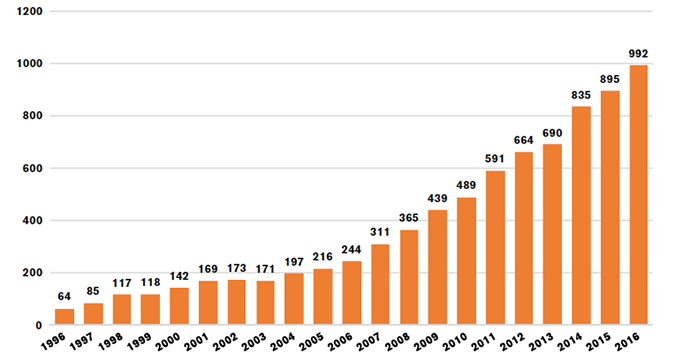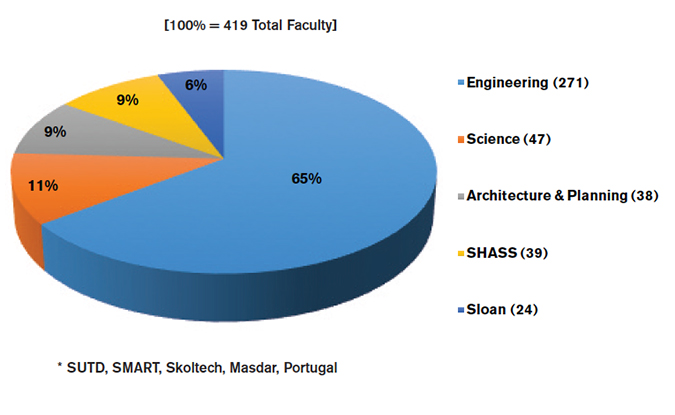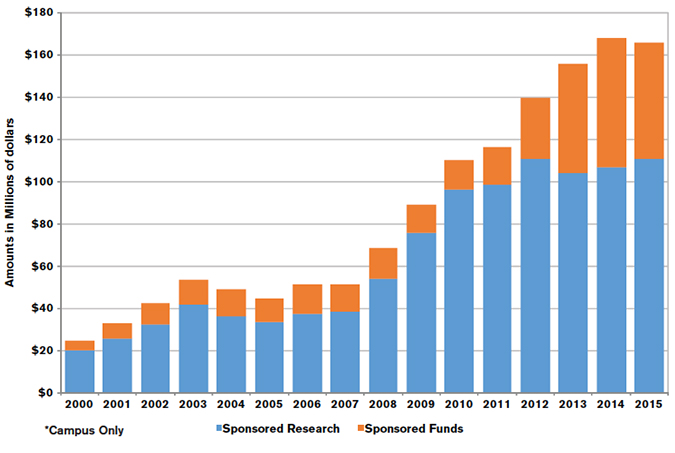Global MIT
This article first appeared in the MIT Faculty Newsletter, Volume XXIX No. 1, September/October 2016.
The MIT community is magnificently but unselfconsciously multinational. With 42% of our faculty, 43% of our graduate students, and 65% of our post-docs hailing from countries other than the U.S., and 151 countries represented on our campus, MIT is truly “of the world.”
We are also, increasingly, in the world. Today MIT faculty and students are working in more than 75 countries, and 50% of this year’s graduating seniors reported having had at least one international educational experience, up from 23% in the class of 2006 (see Figure 1).
For some students this meant traditional study-abroad programs at other universities. For many more it meant practical internships and experiential learning opportunities, often preceded by country-specific cultural and historical education and language training. A big part is played by MISTI, which last year arranged almost 1000 student placements in 30 countries (70% for undergraduates) – a fourfold increase in the last 10 years (see Figure 2). Other important contributors to our hands-on international offerings include D-Lab, IROP, the Public Service Center, the Tata Center for Technology and Design, and Sloan’s Action Learning programs. Mens et manus is alive not just in Cambridge but around the world.
(MISTI year runs from September 1- August 31. 2016 represents the 2015-2016 year.)
Digital learning is helping to expand our international reach. Since its launch in 2003, the pioneering OpenCourseWare Website has received nearly 200 million visits from every country in the world, and 3.5 million learners – 75% of them from outside the U.S. – have signed up for MITx courses since 2012.
MIT researchers themselves range almost as widely, like EAPS professors Olivier Jagoutz and Leigh Royden and their students measuring tectonic displacements in the wilds of the Himalayas, or political scientist Fotini Christia braving wilds of a different kind to study conflict and cooperation in Afghanistan and Yemen, or the team of MIT physicists contributing to epochal discoveries at the Large Hadron Collider on the Franco-Swiss border.
MIT has also been deeply involved in major institution-building projects around the world, including the Singapore University of Technology and Design, the Singapore-MIT Alliance for Research and Technology (SMART), the Masdar Institute in Abu Dhabi, and Russia’s new Skolkovo Institute for Science and Technology.
Another major MIT program, to help upgrade engineering research and education in Portugal, is now in its tenth year. During the last decade, 419 MIT faculty members – or roughly 40% of the faculty – have participated in at least one of these five big projects (see Figure 3). Other large international institution-building projects have been coordinated at the school or department level, such as the development of the Asia School of Business in Malaysia (by the Sloan School) and the collaboration with King Fahd University of Petroleum and Minerals in Saudi Arabia (Mechanical Engineering.)
International engagements have been the fastest-growing part of MIT’s portfolio over the last decade (see Figure 4), and further growth is all but certain. Our students are seeking more high-quality opportunities to learn about and engage with the world. Our faculty are well aware that research funding is growing in many countries, even as U.S. support for R&D falters. And MIT itself, at the top of the international university rankings and widely recognized for its strength in combining innovation with research and education, is much in demand as a partner by governments and universities around the world. International firms are also showing increasing interest, and now account for more than half of all corporate R&D funding on campus.
These trends raise important questions. Collectively, what are we trying to do in the world? What impacts do we seek, and with what priorities? How successful have we been thus far? How can we ensure that our international efforts don’t deplete but rather and strengthen our Cambridge campus, the “mother ship” and source of our excellence, creativity, and energy?
Of course, much of what we do internationally will continue to grow out of individual faculty initiatives. That is as it should be, and a major part of my job as Associate Provost for international activities is to support individual faculty activities and help ensure that our faculty and students can do their best work, wherever they are in the world.
But some of our international initiatives are larger in scale and require more coordination. Many international research projects undertaken by our faculty – for example, on clean water, public health, environmental sustainability, low-carbon energy, and urbanization – have this character, and so do our institution-building projects. There are many more of these kinds of opportunities than we can accommodate. So we need to set institutional priorities. Another role for my office is to help in this task.
With this in mind I launched a strategic review at the beginning of the year, and will complete it by year’s end. As part of this review, our team has been seeking the views of faculty, staff, students, and administrators on what MIT has been doing and what we might do in the future. The team has also been consulting with colleagues at other universities and with outside advisors and partners. I myself have discussed this subject with more than 300 members of our community in recent months. This article is a brief progress report. My main purpose is to share with the faculty a few observations about certain strategic questions that MIT must address in the international arena, and to invite your comments on these important subjects.
* * * * *
Writing in these pages a few years ago, then-Provost Rafael Reif described MIT’s approaches to international engagement, and his article remains the most comprehensive statement of what we are doing and why [MIT Faculty Newsletter, Vol. XXIII No. 3, January/February 2011]. When we engage overseas, our goals include:
- providing educational opportunities to help prepare our students to become global leaders;
- applying discoveries, inventions, and innovations at the frontiers of knowledge to help solve the world’s biggest problems;
- attracting the most talented students, faculty, and staff to MIT from around the world;
- enabling our faculty and students to engage with the world’s most outstanding researchers the best scientific capabilities;
- accelerating and magnifying the impact of our research and educational activities;
- strengthening MIT by diversifying and expanding our international funding sources.
It usually isn’t possible to achieve all of these goals in a single international engagement. But, broadly speaking, the larger the engagement, the more of them we might hope to realize.
My review has highlighted three kinds of international activity that seem particularly important to our community and that to some extent differentiate us from our peers.
- First, to help prepare our students for productive, rewarding, and consequential lives and careers, we are building out a global classroom for them. But this isn’t a conventional classroom. We want our students to learn about the world in the same way they learn at MIT itself – by doing. So MIT’s global classroom similarly emphasizes hands-on learning and practical problem solving. MIT may be unique in the extent to which these experiences have been integrated into our undergraduate education programs. Today about half of our students are participating. Perhaps, as with UROP, we should encourage all of them to do so, though a new funding model may be needed to accommodate the needs of students with fewer financial means. (We are simultaneously developing a different kind of global classroom – a low-cost digital or blended classroom for non-MIT learners all over the world who aspire to MIT-quality education.)
- Second, we are a global catalyst of innovation. The greatest agents of our impact are, of course, our alumni – now more than 130,000 strong, many of them living and working overseas. In addition, governments, universities, and philanthropists around the world are asking us to contribute directly to their human development goals, by importing MIT policies and practices for education, research, innovation, and entrepreneurship, and by inviting us to help them build entrepreneurial, impact-driven universities modeled after ours.
- Third, we are a global problem-solver. Our entrepreneurial, outward-looking faculty will go wherever in the world important problems are to be found, and where their knowledge, insights, methods, and rigor can help to solve them.
But while our individual faculty indeed go almost everywhere in pursuit of their intellectual and educational objectives, MIT itself must be more strategic in its institutional engagements.
We can enhance our impact by committing to being present in a particular place on a significant scale and for an extended period. But when we do this we also incur opportunity costs both at home and elsewhere, especially with a faculty of more or less fixed size. A brief and partial tour d’horizon suggests what is at stake:
China. We must expand our engagements in and with China, for the simple reason that Chinese researchers will increasingly be present at the frontiers of science and technology, where MIT faculty and students must also be. China’s breathtaking economic rise over the last two decades has been accompanied by an equally remarkable expansion of its research infrastructure. China is now second only to the U.S. in total R&D spending, accounting for 20% of the world’s total in 2013, compared with 27% in the U.S., and by the end of the decade China may well become the world leader by this metric [National Science Board, Science and Engineering Indicators – 2016, Chapter 4, Research and Development: National Trends and International Comparisons]. But America’s future relations with China are likely to grow more complicated, with new potential for conflict as well as cooperation. Strategic rivalries will intensify in different parts of the world, and economic competition will aggravate political strains over trade and technology. At the same time, cooperation on climate change mitigation, clean energy, environmental sustainability, and other issues will likely increase. We must expand our engagement with China, while being prepared for periods of political confrontation and the risk of arbitrary government action. We must also recognize that China is not moving towards an open innovation economy any time soon, and that the Chinese government will try to maintain a tight grip on its scientific and technological infrastructure. MIT thus faces the challenge of operating in an asymmetric information environment, in which new scientific knowledge, including new knowledge we ourselves help to create through our collaborations with Chinese colleagues, may not flow as freely in China as here. Our longer-standing engagements elsewhere in Asia, including Japan, Korea, Taiwan, and Singapore, are free of most of these complications, and will continue to be important to us even as we consider new possibilities in China.
India. MIT has a long history of deep engagement with India, including successful post-independence institution-building projects at IIT Kanpur, the Indian Institute of Management in Calcutta, and the Birla Institute for Technology and Science. Today the Tata Center and the Jameel Poverty Action Lab (JPAL) are both very active there. India’s openness, democratic government, enormous population of young people with aspirations for higher education, deep traditions of scientific excellence, huge development and modernization challenges, and a generally cooperative political relationship with the U.S. make it a natural focus for MIT collaborations. So, too, do the interests of many of our current faculty. But bureaucratic and financial hurdles are significant, and progress in building institutional partnerships is likely to be slow.
Europe. MIT’s closest international ties historically have been with Europe, and today we continue to have important academic, industrial, and government partnerships with many European countries, including France, Spain, Portugal, Switzerland, Germany, the U.K., Italy, the Netherlands, and Luxembourg. Last year European firms provided more funding for on-campus research at MIT than did American firms. Europe will continue to struggle with the challenges of integration and slow economic growth, but it will remain a global leader in higher education and science, and new opportunities for collaboration will continue to emerge.
Middle East. MIT has become much more active in this region over the past decade. The recent sharp decline in the world oil price is creating serious fiscal problems for several governments, but it is also driving efforts to accelerate the transition to less oil-dependent, more-diversified economies. Reforming leaders in the region see MIT’s presence as a valuable catalyst of technological, economic, and social transformation. The involvement of American universities is also prized as evidence of broader American commitment to the region, and current uncertainty about the direction of U.S. policy is likely to encourage efforts by governments in the region to engage with us. So the opportunities for MIT in the region will grow. But strong resistance to modernization will persist in some countries, and it seems certain that sectarian conflict will continue to destabilize the region for many years if not decades to come.
Africa. Out of all the world’s regions, we have been least active in Africa. Here it is surely funding constraints that have been primarily responsible, rather than an absence of challenges. Indeed, Africa – the world’s fastest growing region in recent years – contains a multitude of important problems of great interest to many MIT faculty and students, including public health, water and environmental quality, rapid urbanization, the spread of social, digital, and transportation networks, and access to education. To succeed in future engagements in Africa we will need to find a sustainable funding model. We will also need to identify long-term strategic partners who can compensate for gaps in our own know-how and experience. And, as in other parts of the world, concentrating our efforts in countries with democratic leanings and a strong commitment to education and STEM development will increase the likelihood of success.
Latin America. In Latin America, too, we have been less active than in other parts of the world, and again it is funding constraints that have been the primary reason. A major target of opportunity is Mexico, whose economy is so tightly integrated with ours – especially in important manufacturing sectors, where the two countries will largely sink or swim together. More broadly, the U.S. has an enormous stake in the prosperity, security, and political development of the Latin American region, and for MIT there may also be a related opportunity to strengthen our connections to the domestic Latino community, which will likely become more active in helping to shape U.S. relations with Latin America. Strengthening our academic and industrial partnerships in Mexico and elsewhere in Latin America can thus help to advance MIT’s domestic and international objectives simultaneously.
* * * * *
So where should we be in the world? During a recent discussion of this question with an MIT advisory committee, one strongly-expressed view was that we should focus on places and partners that are excellent in research and strong in innovation, ideally with strengths complementary to ours, from whom we can learn and with whom we can jointly maximize our impact. Another view, equally forcefully expressed, was that we should concentrate on locations where the challenges and needs are greatest, where we can most effectively pursue our mission of working for the betterment of humankind. The best answer is likely some combination of the two, but perhaps with somewhat greater emphasis on the latter – including Africa and Latin America – than we have managed until now. This, however, will require new funding models, possibly involving resource transfers from richer to poorer parts of the world.
Another question: How should we operate in regions of the world with cultural values different from ours – in the Gulf, for example, where we’re seen as an agent of social and economic transformation, but where our own students and faculty may face restrictions on their ability to operate?
The fundamental principle here is clear: our international activities must be an integral part of what we do, not something separate. So wherever we are working in the world, we should be guided by the same core values that inform life and work on our own campus.
To my knowledge there is no official recitation of these values, but I think most faculty colleagues would concur with the majority of the following statements:
- We generate, disseminate, and preserve knowledge for the betterment of humankind.
- We engage our students in rigorous academic study and introduce them to the excitement of discovery.
- We collaborate with others to bring knowledge to bear on the world’s great challenges.
- We seek excellence in everything we do.
- We encourage intellectual risk-taking and experimentation.
- We insist on:
- honesty and integrity in all academic and personal dealings;
- respect for others;
- a commitment to diversity;
- fairness and equity in the treatment of all individuals and groups;
- faculty autonomy and institutional independence; and
- freedom of expression, communication, publication, and movement of people.
I believe that if MIT’s name is going to be used in association with an international activity we must be confident that these values will guide the conduct of that activity. So, for example, MIT ought only to enter into research or other academic engagements in a society whose cultural norms appear to us to be biased against women if we are confident that these activities will be carried out with no restrictions of any kind on our women faculty and students, or on female collaborators if they are working under MIT auspices. However, I do not think that we should require others in that society to adhere to our values as a condition of our institutional engagement. In other words, when we work overseas we should take every opportunity to “export” our values. But the right way to do this is to show by our own example how we do things at MIT, not to insist on persuading others to do things our way.
A third topic: If, as seems certain, MIT’s future will lie increasingly in the international arena, what does this mean for our status as an American institution? As a faculty, the most important work that we do is inherently international. Collaborating with colleagues to advance the frontiers of knowledge; educating and mentoring our excellent students from around the world; preparing them for leadership: this work can thrive only in a world in which information and people move freely and openly. But the notion that we could exist as a purely global university, jurisdictionally unmoored and owing allegiance only to the universal laws of science and reason, is illusory. Even as our international engagement grows, we will continue to depend on the American taxpayer for much of our research funding. No less important, we are the beneficiary of American laws, regulations, and other public goods – including safety and security – that our government provides. What obligations does this create for us in the international arena? Of course, we must always comply with the relevant federal and state laws. Beyond this, when ought we to consider the national interest, and what exactly would that mean? To be sure, our institutional preferences will sometimes differ from the policies of the government of the day. And where we disagree with such policies we should make this clear to our government, so that there are no surprises. But as an institution that is both in the world and worldly, we may encounter situations where competing national interests are at stake. In such cases I believe that there should be no doubt, either at home or abroad, that as far as our own actions are concerned we will never put any other country’s interests ahead of those of the U.S.
* * * * *
Our strategic review encompasses other important questions too. For example, under what circumstances, if any, ought MIT to consider a permanent presence overseas? (It is worth noting that we have now been present in Singapore on a substantial scale for almost two decades. Only at Lincoln Laboratory, less than 20 miles from Kendall Square, have we been continuously present at an off-campus location for longer.) Ought we to consider raising the cap on international students in undergraduate admissions? Should we actively seek to increase the international involvement of faculty from those of our Schools – especially SHASS and the School of Science – that have been less represented in MIT’s international engagements to date? Are our on-campus intellectual and administrative capabilities adequate to support our international goals? And as we work to strengthen our own innovation ecosystem based here in Cambridge, should we also be engaging jointly with other participants in that ecosystem in our international activities? Should we be looking for opportunities not only to partner with universities elsewhere, but to build international partnerships at the ecosystem level – perhaps even a network of some of the world’s most dynamic innovation hubs, each with a comparative advantage in a different area, working together to address some of the world’s great challenges – like climate change mitigation, or clean water, or physical and cybersecurity?
Many of these topics will require thoughtful and rigorous consideration by our faculty. I plan to report to the faculty in a few months on what concrete steps we might take to advance our goals for international engagement and how best to consider and develop these. In the meantime, I welcome your comments and suggestions.








